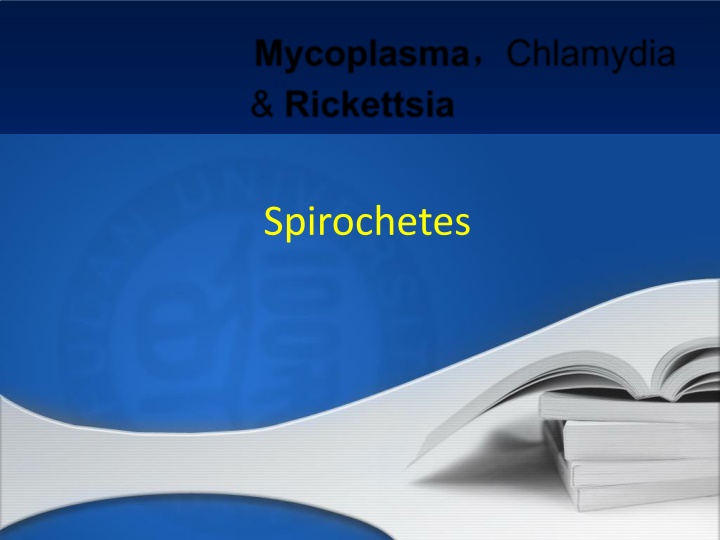Spirochetes
Spirochetes are Gram-negative bacteria characterized by their long, thin, helical shape and unique locomotion using periplasmic flagella. This article delves into the taxonomy of spirochetes, including orders, families, and genera such as Treponema and Borrelia, highlighting their association with human diseases like syphilis, Lyme disease, and leptospirosis. Explore the physiology of Treponema pallidum, the causative agent of syphilis, and learn about the transmission, symptoms, and impact of this disease. Gain insights into the diverse diseases caused by spirochetes and their importance in human health.
Download Presentation

Please find below an Image/Link to download the presentation.
The content on the website is provided AS IS for your information and personal use only. It may not be sold, licensed, or shared on other websites without obtaining consent from the author.If you encounter any issues during the download, it is possible that the publisher has removed the file from their server.
You are allowed to download the files provided on this website for personal or commercial use, subject to the condition that they are used lawfully. All files are the property of their respective owners.
The content on the website is provided AS IS for your information and personal use only. It may not be sold, licensed, or shared on other websites without obtaining consent from the author.
E N D
Presentation Transcript
Taxonomy Order: Spirochaetales Family: Spirochaetaceae Genus: Treponema Borrelia Family: Leptospiraceae Genus: Leptospira 3
Spirochetes Gram negative Long, thin, helical - spirochete from Greek for coiled hair Periplasmic flagella (axial fibrils or endoflagella), -mobile -differering numbers of endoflagella according to genus &species Outer sheath encloses axial fibrils wrapped around protoplasmic cylinder A helical protplasmic cylinder with a peptidoglycan layer similar to G-B, outer membrane, cytoplasmic membrane, andcytoplasm axial filaments locomotion between peptidoglycan layer/outer membran 4
Tightly Coiled Spirochete OS = outer sheath AF = axial fibrils Leptospira interrogans AF 5
*Spirochaetales AssociatedHuman Diseases Genus Species Disease pallidum ssp. pallidum pallidum ssp. endemicum pallidum ssp. pertenue T. carateum Syphilis Bejel Yaws, framboisie Pinta Treponema (3 subspecies) burgdorferi recurrentis Many species Lyme disease (borreliosis) Epidemic relapsing fever Endemic relapsing fever Borrelia Leptospirosis (Weil s Disease) Leptospira interrogans 6
Treponema pallidum Physiology -Strictly human pathogen -Slow replication (time of replication = 30 hrs) Treponemapallidum -Too thin to be visible in light microscope ( darkfield, fluorescence) -Do not survive well outside of host -Not cultivable Darkfield Microscopyof Treponema pallidum 7
Syphilis Transmission - sexual contact, genital - congenital in utero or during birth - transfussion of blood Not highly contagious (~30% chance of acquiring disease after single exposure to infected partner) , but transmission rate dependent upon stage of disease Long incubation period during which time host is non-infectious Chronic infection slowly progressive 8
Primary lesion chancre (painless) (10 to 60 days) area of ulceration/inflammation shedding of spirochetes Secondary (2-10 weeks later) systemic spread disseminated mucocutaneous rash highly contagious Tertiary rare skin, central nervous system delayed hypersensitivity few organisms * control by immune response (several years later) 12
Congenital Syphilis Congenital syphilis results from transplacental infection T. pallidum septicemia in the developing fetus and widespread dissemination Abortion, neonatal mortality, and late mental or physical problems resulting from scars from the active disease and progression of the active disease state Deformed faces Neonatal death Bone deformities Blindness Deafness Dental deformities,saddle nose Skin rashes 10
Diagnosis -Treponema pallidum Not culturable Dark field microscopy actively motile organisms (brightly lit against dark backdrop, light shines at an angle, reflected from thin organisms, enters objective) Fluorescence microscopy antibody staining Serology for Secondary and Tertiary Syphilis Screening method Specific diagnosis - Abs to cardiolipin (self antigen) - Abs to treponemal antigen 11
Diagnosis of Syphilis Evaluation based on three factors: Clinical findings. Demonstration of spirochetes in clinicalspecimen. Present of antibodies in blood or cerebrospinalfluid. More than one test should be performed. No serological test can distinguish between othertreponemal infections. 12
Treatment Penicillin remains drug of choice WHO monitors treatmentrecommendations 7-10 days continuously for earlystage At least 21 days continuously beyond the earlystage G PNC for congenital and late, TTC, ERY, Chloramphenicol (CMP), etc. Prevention and control Vaccine not available, Prevention with barrier methods (e.g., condoms) Prophylactic treatment of contacts identifiedthrough epidemiological tracing 13

